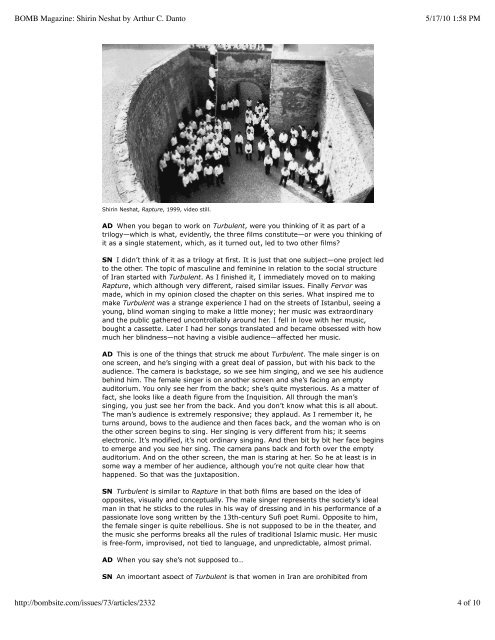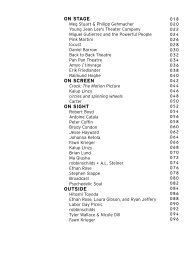BOMB Magazine: Shirin Neshat by Arthur C. Danto
BOMB Magazine: Shirin Neshat by Arthur C. Danto
BOMB Magazine: Shirin Neshat by Arthur C. Danto
Create successful ePaper yourself
Turn your PDF publications into a flip-book with our unique Google optimized e-Paper software.
Iranian crew.<br />
<strong>BOMB</strong> <strong>Magazine</strong>: <strong>Shirin</strong> <strong>Neshat</strong> <strong>by</strong> <strong>Arthur</strong> C. <strong>Danto</strong> 5/17/10 1:58 PM<br />
<strong>Shirin</strong> <strong>Neshat</strong>, Rapture, 1999, video still.<br />
AD When you began to work on Turbulent, were you thinking of it as part of a<br />
trilogy—which is what, evidently, the three films constitute—or were you thinking of<br />
it as a single statement, which, as it turned out, led to two other films?<br />
SN I didn’t think of it as a trilogy at first. It is just that one subject—one project led<br />
to the other. The topic of masculine and feminine in relation to the social structure<br />
of Iran started with Turbulent. As I finished it, I immediately moved on to making<br />
Rapture, which although very different, raised similar issues. Finally Fervor was<br />
made, which in my opinion closed the chapter on this series. What inspired me to<br />
make Turbulent was a strange experience I had on the streets of Istanbul, seeing a<br />
young, blind woman singing to make a little money; her music was extraordinary<br />
and the public gathered uncontrollably around her. I fell in love with her music,<br />
bought a cassette. Later I had her songs translated and became obsessed with how<br />
much her blindness—not having a visible audience—affected her music.<br />
AD This is one of the things that struck me about Turbulent. The male singer is on<br />
one screen, and he’s singing with a great deal of passion, but with his back to the<br />
audience. The camera is backstage, so we see him singing, and we see his audience<br />
behind him. The female singer is on another screen and she’s facing an empty<br />
auditorium. You only see her from the back; she’s quite mysterious. As a matter of<br />
fact, she looks like a death figure from the Inquisition. All through the man’s<br />
singing, you just see her from the back. And you don’t know what this is all about.<br />
The man’s audience is extremely responsive; they applaud. As I remember it, he<br />
turns around, bows to the audience and then faces back, and the woman who is on<br />
the other screen begins to sing. Her singing is very different from his; it seems<br />
electronic. It’s modified, it’s not ordinary singing. And then bit <strong>by</strong> bit her face begins<br />
to emerge and you see her sing. The camera pans back and forth over the empty<br />
auditorium. And on the other screen, the man is staring at her. So he at least is in<br />
some way a member of her audience, although you’re not quite clear how that<br />
happened. So that was the juxtaposition.<br />
SN Turbulent is similar to Rapture in that both films are based on the idea of<br />
opposites, visually and conceptually. The male singer represents the society’s ideal<br />
man in that he sticks to the rules in his way of dressing and in his performance of a<br />
passionate love song written <strong>by</strong> the 13th-century Sufi poet Rumi. Opposite to him,<br />
the female singer is quite rebellious. She is not supposed to be in the theater, and<br />
the music she performs breaks all the rules of traditional Islamic music. Her music<br />
is free-form, improvised, not tied to language, and unpredictable, almost primal.<br />
AD When you say she’s not supposed to…<br />
SN An important aspect of Turbulent is that women in Iran are prohibited from<br />
singing in public, and there are no recordings <strong>by</strong> female musicians. The piece took<br />
off in various directions and brought about other important questions about the<br />
http://bombsite.com/issues/73/articles/2332 male and female contrast in relation to the social structure. The ultimate question<br />
4 of 10<br />
was how each would go about reaching a level of mystical expression inherent in<br />
the Sufi music.<br />
AD But her song is not a traditional song.






